Text
Showreel 4/6
or The most important part
In this post I will cover my showreel research and my showreel progress.
Softwares used:
Premiere Pro
After Effects
0 notes
Text
Industry pitched CV (6/6)
or How to build an Animator's CV for an indecisive student.
This post serves as both artefact of my CV development and as a personal research library. This being said,
Animation CV - Research
A compilation of tips I gathered from various sources (including word of mouth from employers and the lectures) over time:
I have only 10 seconds to make an impression.
Relevant industry experience, education and skills are king, however design and personality/attitude will seal the deal.
Include my roles within the University, the Union and any achievements, show my dedication for everything I have ever done.
Don’t make them hunt for relevant information - make myself easy to contact, approachable -> easy to employ.
Saved as a PDF and uploaded to my website on your Bio/About page
Logo at the top, same font throughout.
Make sure key, relevant/key info stands out.
One standard CV for all employers is not enough, always update and tailor.
Be positive and concise, 1 page should be the maximum length; use the space wisely.
Make it look clean, polished, fresh and memorable, professional, but not too serious and humble.
Information needs to be legible and not off-putting.
Just like with logos, look extremely close and extremely far-away, make it readable and recognizable. Follow strong shapes and the natural flow of a first glance. Show it to other people always.
Is your CV appropriate for your industry? - priority structure
Star method for experiences, show what you've gained.
Classy fonts - always.
The list could go on based on everything I have ever heard, because each employer is different, what matters is that my CV gets the point across. Here are some sources and their varied advice:
About Me section: "Consider the tone of voice you use here; if the role you’re applying for is for a characterful agency, it might be best to use a less serious tone of voice." References section: "When it comes to references, it’s best to write something along the lines of “References available on request”, particularly if you’re already working somewhere."

"We’ve all done that thing where you’ve exported a hundred variations of one file, or quickly smashed the keyboard and saved a document as ‘KWJEbfkwejg8vd.pdf’ or similar. We get it, we’ve all been there, but now’s not the time for it. With so many job applications being submitted online, take care when naming the files you upload to sites. Keep it clean and simple with your full name, job title and the current year. Not only does it make it easier to file and find, it shows that you sweat the details. For example: ‘JoannaDoe_GraphicDesigner_CV_2021.pdf’ We suggest keeping a working file of your CV, so that it’s easy and simple to update as you apply to more jobs in the future. And having a clear label will make it easier for you to find and refer to later on, too."
Key takeaways • Keep your CV clean and simple • Go for quality over quantity • Tailor each CV to the job application • Keep it concise; your CV shouldn’t be too long, too detailed, or over-designed (you don’t want to overwhelm anyone!)
🔔 Your CV doesn’t have to get you work
Remember: your CV won’t necessarily be the thing that gets you the job. It just has to grab someone’s attention enough that they want to talk to you.
" I think the best piece of advice I can offer is ‘keep it simple’. (..) Avoid old-fashioned fonts like Times New Roman, and make your headings stand out by using bold fonts. There is no need to start your CV with the words Curriculum Vitae – it’s just stating the obvious. Think about how you name the document itself – include your full name and the month/year to show that the CV is current, eg: ‘ Joe Bloggs CV June 2011’."
1. Make it clear what you do and what job you want. 2. Don’t make it wordy. a very short biography is best (..) 5. Keep your CV 1 page max and keep your education short.
"Not including examples of your work with your résumé is a common mistake. It's all very well telling a potential employer about your experience on your CV, but showing always beats telling, and designers work in a profession where it's possible to do that. How? You could include images directly in the CV itself, in a separate portfolio document (usually best as a reduced, curated version of your portfolio in PDF format) or as a link to an online portfolio. If you work with motion, stills will usually suffice, unless you’ve been specifically asked to include a showreel. See our selection of great graphic design portfolio examples for inspiration. "
How to Get Hired When You Are Just Starting Out
1. Include personal projects to bulk up your resume. 2. Don’t just list the facts; tell your story instead. 3. Showcase your creative process by sharing iterations and mockups. 4. Hiring managers expect tailored applications. Do your research before hitting send. 5. Don’t be afraid to mention your idols, mentors, or creatives you admire in an interview.
Tips from Creative Careers:
List your skills but avoid using infographics to grade your level of skill. "They’re meaningless. What does '95% in Photoshop' mean? Absolutely nothing."
Don’t include: photo, marital status, National Insurance number, nationality, gender, age or date of birth
Listings in reverse chronology
Describe responsibilities using an action verb at the beginning of each sentence
Interests: no socialising, no travel (too common), try including team and quieter interests, try showcasing somewhat related interests, ex.: for an animator, cinematography or arts history etc.
Your CV must be no more than two pages and some employers like a one-page CV
Make sure each page is full otherwise it looks like you ran out of things to say
Order the sections to ensure your strengths stand out
Be consistent in font, spacing, text alignment
Use clear headings
Avoid long paragraphs – concise bullet points are easier to read
Be sure the document photocopies well and is email-able
Visually interesting CV Examples from the industry:

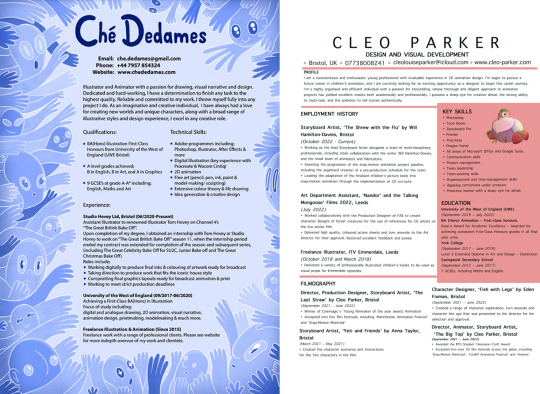
Source: https://www.screenskills.com/
Skills, skills, skills
Considering the information I gathered in my industry research and some other sources, here is a little breakdown I made of the most sought after skills in the Animation industry:
Artistic skills and basic animation skills:
Colour theory
Drawing, composition and lighting
Storyboarding
Strong visual imagination
Animation fundamentals - principles, an understanding of movement and body mechanics
3D rendering
Editing
Top software tools to know:
Adobe Suite - it is a must! Photoshop, After Effects and Premiere - confident user
Autodesk Maya - must know proficiently!
Blender - booming in the last few years, definetly a must know.
Zbrush (very useful), 3ds Max, Houdini, Nuke - good to know if possible
Toon Boom Harmony and Cinema 4D
Unreal Engine - it is considered the future of CG Animation
Soft skills:
There are so many and most of them are important, as in this industry it is your character that might just get you the job. Some skills I would like to list, others to showcase (through work and so on) and others I would like to imply through my short statement.
Passion and dedication - imply
Teamwork - list
Communication - list briefly under my student roles experience
Organization - list
Time-management and prioritization - list or imply in the experiences
Ability to work under pressure - imply
Creativity - imply (must, it would be awkward to mention it from a creative industry point of view, so I will showcase through my work and CV layout)
Attention to detail - list
Self-motivation and responsibility - list
Leadership - mention in the experiences
Good criticism handling - hard to show and awkward to mention
Strong analytical thinking - list
Flexibility - list or mention in experiences
Storytelling - showcase by guiding the reader with a good layout, also showcase in my work
Sources:
https://www.rasmussen.edu/degrees/design/blog/animation-skills/ https://animatedjobs.com/vital-soft-skills-every-successful-animator-needs-to-have/ https://www.nobledesktop.com/classes-near-me/blog/top-skills-for-animators https://www.indeed.com/career-advice/resumes-cover-letters/animation-skills https://businessofanimation.com/essential-animator-skills-every-freelancer-should-have/
Despite my fear of working on my personal branding and CV, I quite enjoy researching and working around employability and I often help my friends, no matter the industry. I was helping a friend set up their LinkedIn profile and I have stumbled across this article and I made a mental note about it:
It might be helpful for me to avoid overused words and use better words, especially for my short statement.
These are the 10 words that LinkedIn members overuse the most:
Specialized
Experienced
Leadership
Skilled
Passionate
Expert
Motivated
Creative
Strategic
Successful
Now, visually



The industry is full of very different types of CVs and, while most people prefer simple, straightforward CVs, there is space for creativity.
Most importantly, it has to conform with my branding elements in order to be consistent.
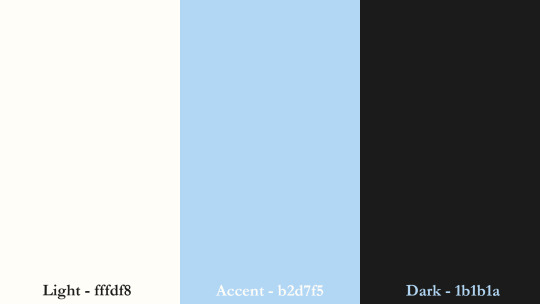
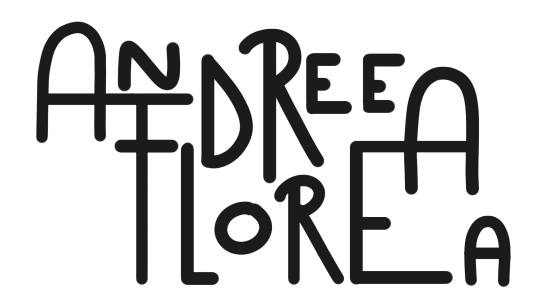
However, I want to find a good, strong, appealing font. The animation industry is not exactly that keen on fonts, so I decided to research the most appreciated fonts in the graphic design and see if I like something.
The typeface
Based on a short research, the most beloved typeface across the internet today is Helvetica. Helvetica is a part of the Humanist fonts and this type originated in the Renaissance, reminiscent of organic human penmanship. Traits:
orderly
caligraphic
easier to read and flowy
However, Helvetica is also a Sans Serif typeface. Sans Serif typefaces are clean, modern, good to use for both titles and body copy, easy to read, stable and sensible. Therefore, the typeface I am looking for is a Sans Serif typeface.
Sources:
https://www.jukeboxprint.com/blog/12-of-the-most-popular-fonts-in-graphic-design https://digitalsynopsis.com/design/font-psychology-emotions/#:~:text=While%20working%20on%20a%20project,%2C%20classic%2C%20stylish%20and%20formal. https://bravadesign.ca/font-psychology-different-types-of-font-meaning/ https://eugenesadko.medium.com/guide-to-10-font-characteristics-and-their-use-in-design-b0a07cc66f7 https://www.fiverr.com/resources/guides/graphic-design/how-to-choose-font-for-logo#:~:text=Learning%20about%20the%20four%20main,of%20brands%20that%20use%20them. https://www.youworkforthem.com/blog/2022/09/10/what-is-a-humanist-typeface/
Here are some typefaces I liked and compared on Adobe Fonts:

And then I found this one that I was planning to use, but unfortunately students don't actually have access to Adobe Fonts.

Then I looked over most fonts on https://www.dafont.com/ and https://fonts.google.com and I found these 2 fonts that fit my requirements:

And I ended up choosing EXO for my CV, website and really everything.
Layout and development
I started with the content I already had in this older CV, that is in Romanian because I used it to apply to summer internships back home.
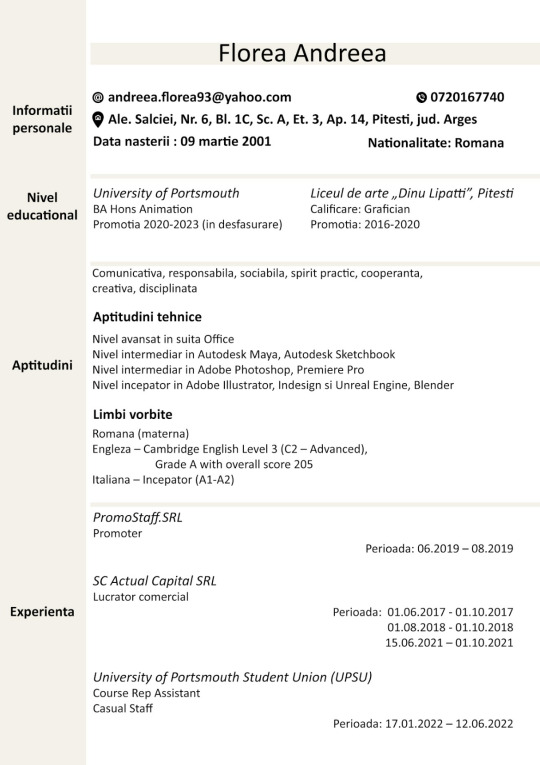
It is very visibly extremely bad, but it is a starting point content-wise.
After researching multiple CV layouts on ScreenSkills, Artstation and Pinterest, I came up with a couple of layouts that I thought fit my logo and content the best. Then I chose one and I got sketching.

My next step is laying out my content: what will be in my CV? Having full control over my CV requires having my content sorted out first and I think there is nothing better than a plain, old Word doc full of the content.
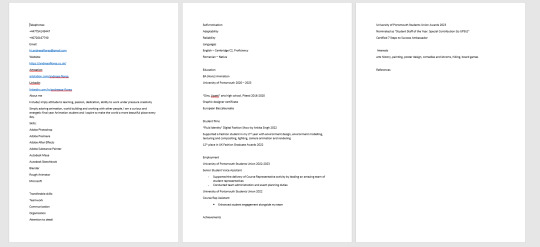
After that, all I need to do is start working on it. Here are some pictures of my development:

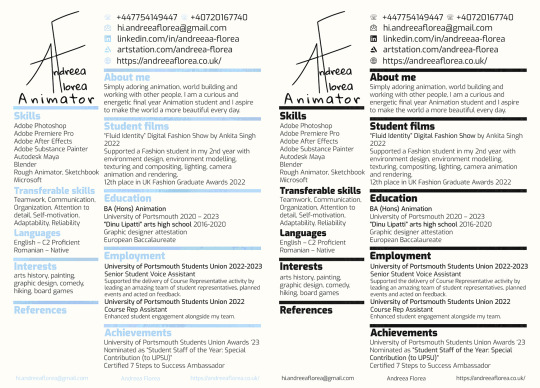
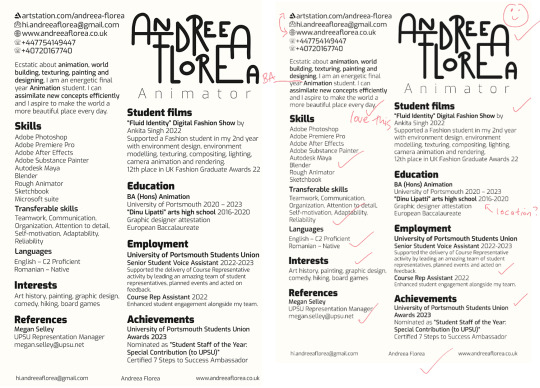
And after I got my feedback and changed my website, here is my final version of the CV, neatly named with my name, unlike all of my other CV1, 2, 3 ... etc.

Thank you for reading!
0 notes
Text
Website design, research and development 3/6
or how to look professional
My website should:
look clean and professional
look consistent
be easy to navigate
have all of my contact information
have a professional domain
Therefore, this post will cover:
Research into website design
Research and development into my domain and email
Research into a website builder
Website curating and setting up
Final result
Research
Tips for an outstanding website: Keep your homepage minimalistic and free of clutter Design with visual hierarchy in mind Create easy to read website content Ensure your site is easy to navigate Stay mobile friendly
Incorporate SEO best practices You may have the best website in your industry, but it won’t do you a bit of good if people can’t find it. While you can spend money on ads to drive prospects to your website, it is more cost-efficient and effective in the long run to bring free organic search traffic to your site. When people are looking for information online, they go to search engines, especially Google. Usually, they find what they are looking for on the first page of the search results, so that is where you want your company to appear. Google and other search engines have their own proprietary algorithms that they use to rank sites for search terms, also called keywords. Search engines use three ways to determine where your listing appears: crawling, indexing and ranking. Crawling means that they find your site through links from other sites. So, make sure that links to your site appear on as many outside websites as possible. After your site is discovered by the crawling bots, it is indexed, which means that it is analyzed for content, including keywords, freshness, relevance, links and multimedia. Make sure that your site has plenty of new, relevant content relating to the keywords you want to rank for.
Respect the need for speed. A study by digital marketing company Akamai found that 88.5% of web users will leave a website if it loads too slowly. Furthermore, the time it takes to load a webpage affects the purchase decisions of nearly 70% of online shoppers. Make sure your website runs smoothly by keeping the software up to date, optimizing videos and images for quicker downloads, and using a website host that can handle your bandwidth demands.
Web Design Tips for Beginners – Everything I Wish I Knew When I Started
BEGIN WITH PENCIL AND PAPER Set yourself DEADLINES K.I.S.S.= Keep it simple, stupid. Use EMPTY SPACE wisely Use LESS COLOUR TRUST YOUR INSTINCTS FOCUS ON THE USER

Examples of outstanding websites
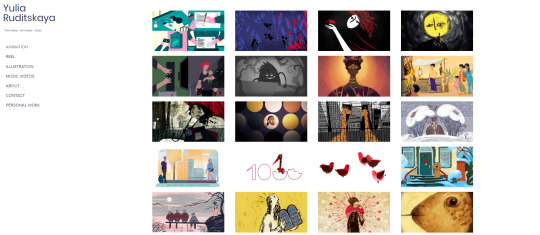
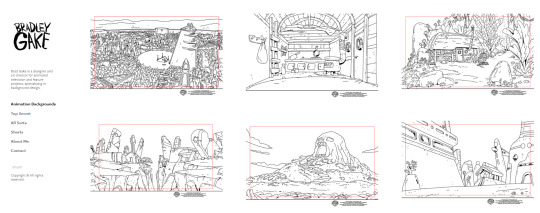


Sources: https://www.wix.com/blog/2017/10/5-design-tips-for-a-professional-site/ https://www.orbitmedia.com/blog/web-design-tips/ https://www.format.com/magazine/galleries/illustration/animation-portfolio-roundup#natalie-young https://carbonmade.com/portfolios/animation https://www.businessnewsdaily.com/9811-effective-business-website-tips.html https://www.smashingmagazine.com/2011/03/web-design-beginners-tips/
Professional domain and email
Getting my own domain proved to be tougher than expected. I started with the Moodle resources and built my way into understanding how domains work. For the domain to be mine it has to be linked to my physical person through my physical world legal address and then the fun begins. But first, let's start with domain providers.
I looked up a couple of domain providers listed on numerous blogs and based on what I have seen online. Here is a little comparison I made.
Then I looked into combinations of my name on all of the best websites.

And I got to the two best ones:

In the end, I chose to go with names.co.uk as it seemed to be free, however I did pay £1 in the end and now I own:

Regarding my email, I did not want to pay so I spent spent some extra time finding a good, professional gmail, looking up professional combinations listed online. I ended up using [email protected] .
Sources https://www.wix.com/blog/2017/10/5-design-tips-for-a-professional-site/ https://www.orbitmedia.com/blog/web-design-tips/ https://www.format.com/magazine/galleries/illustration/animation-portfolio-roundup#natalie-young https://carbonmade.com/portfolios/animation https://www.businessnewsdaily.com/9811-effective-business-website-tips.html https://www.smashingmagazine.com/2011/03/web-design-beginners-tips/ https://sparkmailapp.com/blog/create-professional-email-address-format-examples#:~:text=your%20email%20address.-,Professional%20Email%20Address%20Format,firstnameinitiallastname%40domain.tld https://www.zoho.com/mail/how-to/choose-a-professional-email-address.html https://blog.hubspot.com/marketing/professional-email-address https://www.indeed.com/career-advice/career-development/professional-email-address-examples
Website builder
youtube
I started by watching this video and looking into different website builders, then I chose Cargo.
Me and Cargo
We definitely had a short and tumultuous relationship. Firstly, it did not have my chosen font and uploading it meant coding it into the website and while that did not seem that hard, it was very time consuming. Secondly, using my own domain took a while (about a day) because, while the process was easy - configuring the nameservers, it took a long time to process it. Thirdly, afterwards my domain got blocked by the university VPN which is both a problem in itself and it is making my life hard as it meant working from home and my laptop is very slow. Lastly, the interface is not user-friendly and no matter how many tutorials I followed, it was still a bit rough.
So I changed to Portfoliobox
Portfoliobox is really user-friendly and easy to use in my opinion. It also allows plenty of customization and it hosts my chosen typeface as well. I got another domain from Portfoliobox for now, but I will link it back to my domain after assessments are over.
Website curating and setting up
Let's get to work!
Overall design

Setting up the homepage and universal look


Editing the menu

Editing my footer so that my contact and socials are everywhere

The about me page

Final result
Thank you for reading!
0 notes
Text
How best to Showcase my skills on my website 2/6
or Tailoring my work to my website and my website to my work
My website is essentially my portfolio and it has to look polished and impressive.
Ground rules for my work display:
quality over quantity
consistency
keep updating
research the industry always and tailor the work
My website has to feel natural, as if I am presenting my portfolio myself and it has to be entertaining, social and neat. It also has to be easy to navigate and professional. I would like to include my 2D work, 3D work, illustration and concept work (and some traditional drawing) and most importantly - my showreel.
Now, let's see what the internet has to say:
Whether you are applying for an animator position in stop-motion, CGI or 2D, most employers will be looking for the same thing, great acting, timing and versatility. Chose a selection of clips that show you have a good grasp of the principles of animation and have strong craft skills in things like lip synchronisation, body language and composition. You may also want to include a range of genres to show that you can work with simpler preschool characters as well as more complex characters typical of more mature and feature film quality animation. The general rules of a showreel still apply, so keep it short, and put your best work first. Avoid long, dark scenes and make it as polished as possible. It needs to have that ‘wow’ factor, so ask the advice of an editor to help you make the reel flow nicely. You should also include examples of life drawings and observations from life, particularly drawings that show human expression, anatomy and gesture. Keep attending life drawing classes if you can and it may also be worth taking acting classes too.
Tips for creating a unique animation portfolio: 1. Introduce yourself - the About Me page 2. Include your best work 3. Present your characters 4. Choose quality over quantity 5. Focus on what makes you unique 6. Keep it short 7. Match your portfolio to the role 8. Host your portfolio online
What's in a Portfolio? Life Drawing Object Drawing Character drawing Hand drawing Storyboards Personal projects
The Requirements of an Animation Portfolio: 1. Make an Online Animation Website 2. A Demo Reel 3. 2D and 3D Animation Portfolio 4. Following General Requirements 5. Keep It Relevant 6. Learn How to Share Your Portfolio 7. Showcases Your Animation Style 8. Add a Personal Touch
Insight from our visit to Blue Zoo back in February:
keep 2D and 3D separate
quality over quantity
tailor per studio
and more tips about showreels
Preparing work and development
3D Animation
Besides the showreel that will be on my homepage and on the 3D page I will include work that didn't make it into my showreel, such as stills and progression shots.

Working on the best design for my work showcase.


Making gifs of my animations for a smooth, embedded look.
2D Animation

To showcase my 2D animations I created gifs of them and made slideshow galleries.


Illustration
Selected a few of my paintings and embedded into their own page. I want to add a couple of my traditional drawings, but I have no scans yet.

Decided to add a Concept Art page with some of my work.

Sources: https://www.creativebloq.com/portfolios/examples-712368 https://www.format.com/magazine/galleries/illustration/animation-portfolio-roundup https://www.screenskills.com/starting-your-career/building-your-portfolio/build-your-animation-portfolio/ https://www.cgspectrum.com/blog/tips-to-create-a-unique-animation-portfolio https://www.wix.com/blog/creative/2020/02/animation-portfolios/ https://www.animationportfolioworkshop.com/what-is-an-animation-portfolio/ https://weblium.com/blog/animation-portfolios-examples/ https://businessofanimation.com/8-ways-to-create-an-effective-portfolio-for-animation/
Website:
Thank you for reading!
0 notes
Text
Logo, Branding, Social Media Integration 5/6
or How to project confidence when you are actually very self-conscious
In this post I will showcase my personal branding process and I will as set up all of my professional social media, as well as back up my process with research.
Brand Strategy
Branding is all about being memorable and setting yourself apart from the crowd and while this is quite sad, it is the reality. The animation industry is highly competitive and while my work is the king of my brand, mastering the art of presentation and showcasing my personality might just get me the job.
Things to remember:
I am human. I have a life, I love a plethora of things and I am interested in loads, I am much more than my work and I am not a working robot.
Most people won't give me more than 5 seconds and not everyone has to like me or my work.
Eva once told us that there are jobs for all the different types of personalities.
Be approachable and open.
Tips from different sources across the internet:
YOUR BRAND STRATEGY MUST CLARIFY AND SPECIFY WHO YOU ARE TO MAXIMIZE YOUR SUCCESS WITH THE CONSUMER. You can do this without compromising your artistic ideals because it's not about subjecting your vision to some Hollywood formula. Instead it's about thinking of your individual's or company's unique value and figuring out ways to make the consumer want it again and again.Your brand should project 4 ideas: who you are, what you do, how you do it, and where you want to go.
Who am I:
Another big-eyed animation graduate with even bigger dreams and even bigger self-doubts. I am also a fun person, I love working with people, I love animals, laughing, working, organization, structuring things; I have a strong sense of justice and an even stronger desire to help and I love art in all shapes and forms. And I really hate talking about myself just like everyone else, this paragraph took way too long to write.
What do I do:
I animate, model, paint, texture, edit, draw, create. I can also write, learn quickly, research, speak in public, organize and plan.
How do I do it:
Based on a structure and a timeline, with loads of alterations and often frustrations over my work, but employers don't have to know that.
Where do I want to go:
Where I serve a purpose and make people happy. Animation may be art, but I see art as a service as well: if I want to be a creative person I have to serve the world with my craft, with beauty and always improve. I want to work in any studio, across Europe.
ADDITIONAL BRANDING TIPS Think long term. Know what aspect of your company predominates within the 4 main vectors and use that to your advantage. Also consider working on your weaker aspects so that your strong aspects are not negated. Rethink your current logo, tagline, reel, website, reputation, personal stories, and name(s) in light of the 4 ideas you are projecting in the 4 environments. How you can improve each of those items or spread their influence to strengthen your overall brand. Think about your audience and how they will react to your brand. Your audience consists of two types: the immediate people and the sought-after people. The immediate people are the people who hire you and/or work for you, under you or with you during every phase of production from development to marketing (paid or deferred). The sought-after people are the people all filmmakers search for after they have made their films; the critics, the festival judges, the general moviewatching audience, the film buyers, etc. Since you as a filmmaker will most likely provide both products and services you will be catering to the immediate people AND the sought-after people. Do not undervalue or throw the immediate people under the bus in your quest for the sought-after people. The immediate people are just as important, if not more important, than the sought-after types because they believe in you before the film gets made and you will need them or their peers again for your next film. Remember CONSISTENCY IS THE KEY. Your brand is determined by your ongoing behavior, whether you're working for a company full time or on a production for a limited time. When you work for a company, consider that you will be representing your company's brand and identity as well as your own when you work for them. Can you do so or does it conflict with your ideas, goals and values? If it does conflict, then does working for the company serve your long term needs?
Try to think of your movie or even yourself as a Brand. Your movie is a brand and needs to have a mission statement that the filmmakers are always striving towards. Figure out what your movie's mission statement is. What is it trying to achieve with its story? Every creative decision you make with your movie should be in service of the movie's brand and mission statement.
Mission statement:
(As a child I spent most of my days watching cartoons all day as I was a very quiet child. They were my friends and my support through all of my family issues. Animation is an escape universe and art is healing.)
I want to work in the animation industry because I find it magical and I want to create escapes for all the other people who need it.
A sparse or generic LinkedIn profile doesn't instill a sense of familiarity and trust in potential buyers. Instead, they're left with more questions than answers.
Is this a person I can depend on? Will they be willing to work with me in the way I prefer? What's their take on current industry issues? How can they help me improve my business?
By openly communicating your viewpoint for the world to see, prospects who stop by your social pages can easily decide if they can envision themselves working with you or not.
My brand has to be easy to like, aesthetically pleasing and I need to project reliability, adaptability, interest and a strong desire to help, develop and have a positive impact.
5 Personal Branding Essentials 1. A complete LinkedIn profile. 2. A positioning statement. 3. An SEO-friendly profile. 4. A unique point of view. 5. A consistent posting schedule. Personal Branding Strategy Define your goals. Create a unified theme. Tell your story. Stay human.
10 Golden Rules Of Personal Branding 1. Have a focus. 2. Be genuine. 3. Tell a story. 4. Be consistent. 5. Be ready to fail. 6. Create a positive impact. 7. Follow a successful example. 9. Let other people tell your story.
Sources: http://www.filmstrategy.com/2013/07/production-tips-what-is-your-brand-as.html https://www.huffpost.com/entry/a-brief-guide-to-pitching_b_9842834 https://blog.hubspot.com/sales/the-ultimate-guide-to-personal-branding https://www.forbes.com/sites/goldiechan/2018/11/08/10-golden-rules-personal-branding/?sh=59da4c8958a7
Examples of animator and their brands:
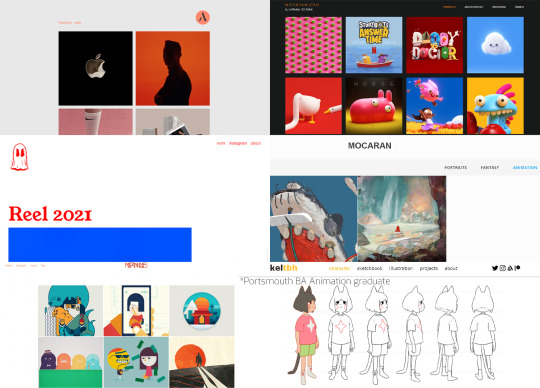
Sources: http://www.adamrowe.tv/ https://ghostkid.co.uk/Reel-2021 https://mutanthands.com/ https://moonjam.com/albums/1028020 https://mocaran.com/albums/783683 https://dribbble.com/search/shots/popular?q=animation https://www.keltbh.com/
They all have:
a colour palette
a simple, neat website
a colour palette
a good logo
all of their socials easily accessible
My brand, visually
The colour palette
I have always wanted to create my personal colour palette to support consistency. I wanted my colour palette to represent me and to be universally useful, so I needed at least two of the colours to be non-colours, but because I don't like pure black and white, I started looking for the perfect soft black and off-white. I was also looking for an accent shade to represent me and to send across the right message, so I looked at my work and I thought: light blue!
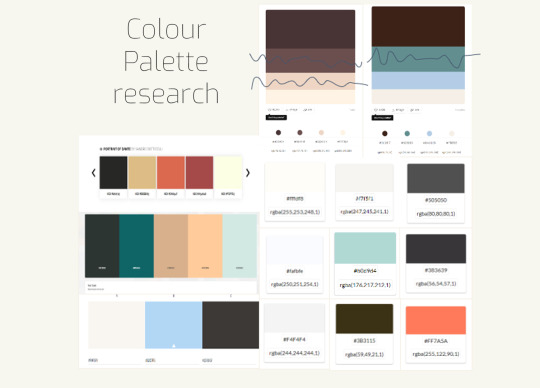
I wanted to make sure that my accent colour sends the right message across so I looked into its colour symbolism.
Light blue is a peaceful, calming color. According to color psychology, blue is associated with trustworthiness and reliability. Blue is also said to promote feelings of tranquility; light blue’s gentle appearance means it is particularly likely to make that impression. Public opinion polls have found that blue is one of the colors most likely to be associated with masculinity. However due to its specific association with baby boys, light blue is more likely to be linked with youth, innocence and childhood than machismo. Blue is a very popular hue—surveys of the North American and European public have found that almost half of the population consider it their favorite color.

Sources: https://colorhunt.co/ https://colordrop.io/ https://color.adobe.com/create/color-wheel http://colorlisa.com/ https://www.canva.com/colors/color-meanings/light-blue/
The logo
This was perhaps the hardest part of my brand building journey, as I never seem to find a logo for myself that I like. So I started playing around with logos and looking for inspiration.
Things I know about logos from learning graphic design:
a good logo is clean and memorable
a good logo is fresh
a good logo will look good in any size and in any context
logos are a lot of work
it is a composition, use the empty space in your favour
be confident in your logo
make it appropriate
What do I want my logo to show:
that I am an animator - animate it
that I am a nice, funny person - find a funky way to write my name
that I am reliable - good structure
my name
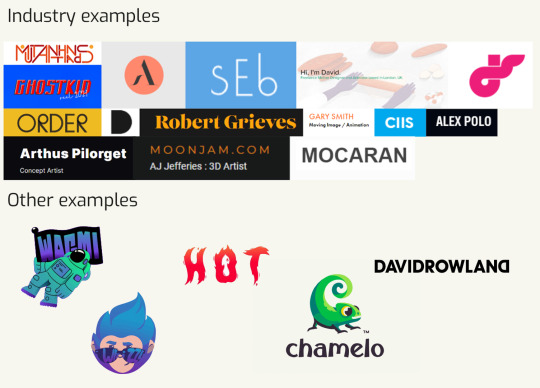
Logo development
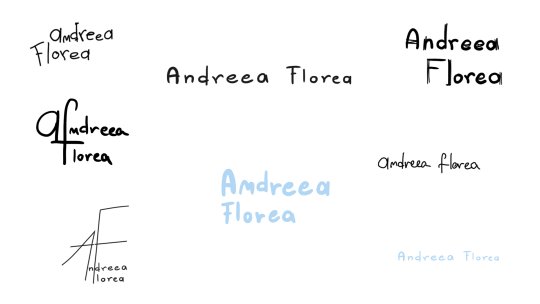
Logo exploration
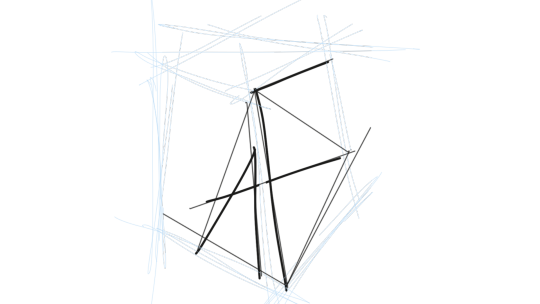

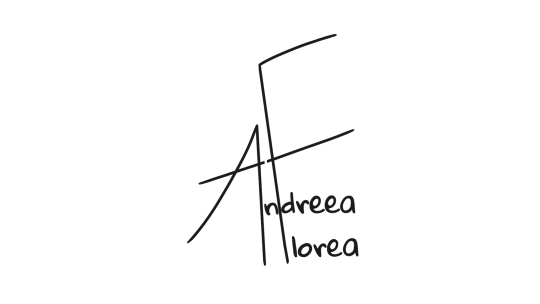
This is the development of my old logo, but in the end I didn't like it anymore. It felt weak and not versatile.
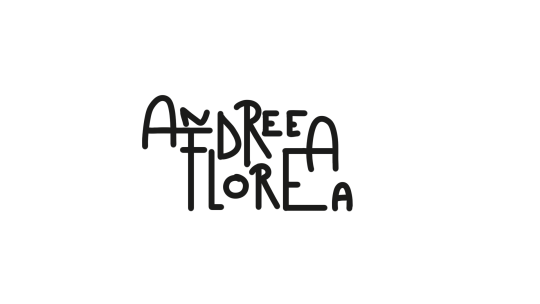
an older version
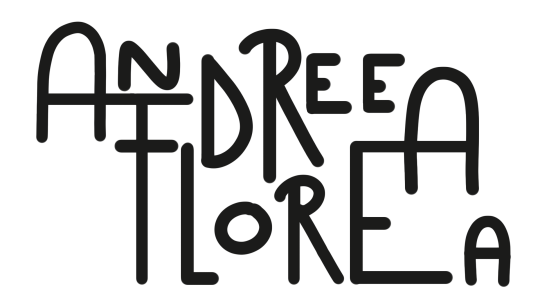
final version in soft black

final version and off-white
Animating my logo

I animated the logo in After Effects as I needed it to look as if it is painting itself.
I have also created a thumbnail avatar painting of myself:
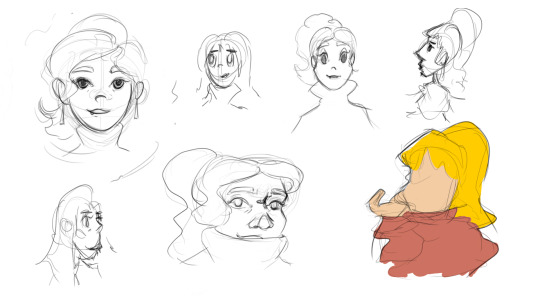
Exploration

Social Media Integration
I have also set up my new professional LinkedIn, Instagram and Artstation and started working on them.
www.instagram.com/andreee.afl
linkedin.com/in/andreeaa-florea

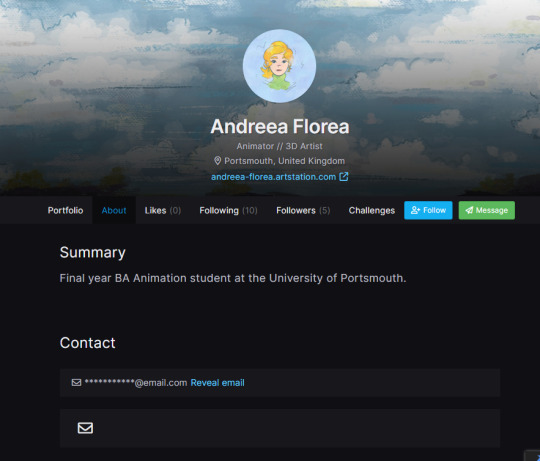

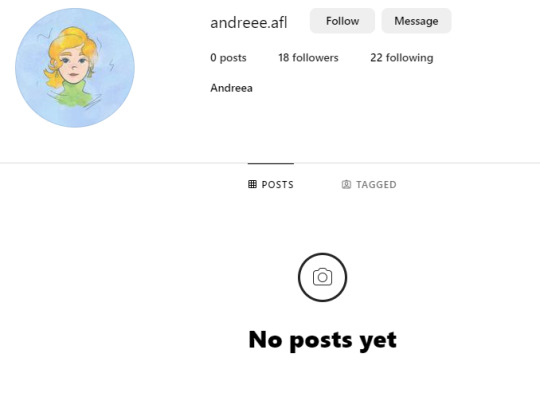
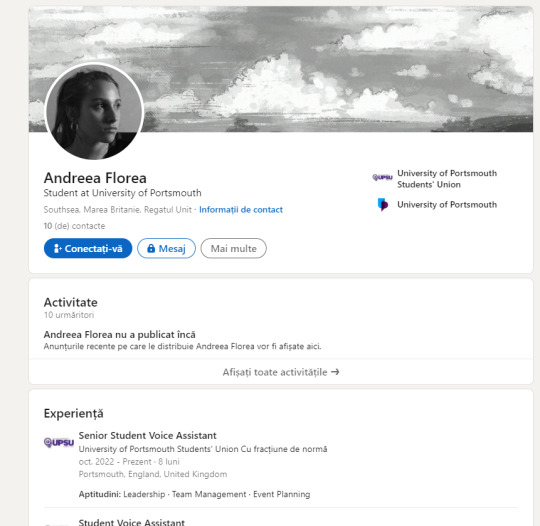
Sources: http://www.adamrowe.tv/ https://ghostkid.co.uk/Reel-2021 https://mutanthands.com/ https://moonjam.com/albums/1028020 https://mocaran.com/albums/783683 https://dribbble.com/search/shots/popular?q=animation https://www.keltbh.com/ https://blog.hubspot.com/sales/hidden-linkedin-hacks-revealed-slideshare
Thank you for reading!
0 notes
Text
Industry role research (1/6)
My aim this teaching block as part of the Employment Preparation Module is to further my career readiness, better my employability prospects and shape my online professional presence.
Goals this teaching block:
Industry pitched CV
Personal branding: logo, layouts, colour palettes, other visual aspects: consistency and authenticity
Website and portfolio
Tailored showreel
Professional looking Instagram
Professional looking ArtStation
Professional looking LinkedIn
Professional looking YouTube
First step, ground research - the animation industry
The skills needed to work in animation are broad and varied. Within a smaller studio, it’s not unusual for an individual to have a wide spectrum of skills and be asked to work across a number of roles. In a larger company, it’s more likely that people will specialise. Less than one third (27%) of people in the animation industry work outside London. However, there are hubs of animation companies in Bristol, Cardiff and Manchester. (..) There’s a shortage of animators, storyboard artists, artists and technical directors in the industry, so people with those skills are likely to be in high demand. There’s also a need for creative people with business skills; producers who can organise an animation pipeline and raise the money for productions. (..) It’s worth noting that a large proportion of people who work in animation are self-employed. It’s estimated that half the people are fulltime staff (53%), 4% are interns, 3% are part-time employees and 1% are apprentices. The other 39% are freelance. In the animation industry, the most common way in which people get jobs is through word-of-mouth – 54% of employers say it’s their most used means of recruiting. The second most common way of getting a job is through company websites (34%) and then through social media sites (18%).
These findings prompt to further research into:
My role within the industry - prospects and skills required
Demand - job adverts, studios and opportunities
Regional and national animation industries across Europe
The future of the industry - expectations to take into account
- Improvement In Quality and Design - Although it’s easy to assume that the animation we see today is already at its highest quality, there’s no doubt that it will get better in the future. - More TV Show Programs for Adults - Animation has been in demand and part of the economy way before the pandemic, but this caused an enormous boom in tv animation for children and adults. - Films Becoming More Hyperrealistic - Another rising trend in the animation industry today is mixing animation with computer graphics animation. - The Future of Animation is in the Use of Machine Learning
A couple of interesting points from https://businessofanimation.com/the-future-of-the-animation-industry/.
My role within the industry
I have been around the arts as long as I can remember. In high school I studied fine arts, having A levels in arts, graphic design and so on, specializing on metal engraving, but I always wanted to do animation. During my university journey I have worked on a variety of animations, however my problem is I never really knew what I wanted to do or what I am good at. Like most people in this day and age I am quite lost, which is my biggest drawback in such a fast emerging industry. The animation industry has evolved in such a way that now you have to start preparing for it as early as possible and you have to know exactly what you want. Sadly, I would (at least at the moment) consider myself a little bit of a generalist, therefore my goal now is to explore possible paths I may take. Here are some industry roles I am interested in:
Lighting artist
Lighting artists light the scenes in an animation. Just as in live-action production, there is a director of photography and gaffer who decide what lights to use and where to place them, so there is a lighting artist in a computer-generated (CG) animation. The difference with an animation is that the lights are created through software and the lighting artist has complete control of what the effects will be.

Lighting artists use light to enhance the atmosphere, tone, depth and mood of a scene. They input different light effects depending on the factors in a frame or scene, such as the weather or the time of day. They make it clear where the light sources are meant to be in a scene.
There’s a technical side to digital animation lighting, which is sometimes done by lighting artists or by lighting technical directors (TDs), depending on the type of studio. Lighting artists light images in such a way that they are easy for the computers to render. They work to create colour keys, which are guides that indicate a range of colour hues in a scene. They use the shader settings to create effects like reflections and the appearance of wet surfaces.
Lighting artists are employed by animation companies or studios, advertisement agencies or graphic or web design companies. Otherwise, they may work as freelancers.
Are 3D artists in demand? Yes! Lighting artists are very high in demand, especially now that streaming services like Netflix, Disney+, and Amazon Prime are coming out with more animated movies. Netflix is making at least eight animated films this year alone, which is insane compared to how often these films were made before streaming services started coming out with their original features.
Key skills of a lighting artist:
Art: understanding colour theory, perspective and design theory, have a strong sense of light and shadow. I have studied composition for a very long time and I enjoy both compositing and lighting scenes.
Understanding lighting: know the scientific principles behind lighting, have a strong knowledge of lighting techniques and materials
Problem-solving: overcome obstacles, use computer technology to find new ways to achieve a creative vision
Working to deadlines: work within given timeframes, be able to complete work under pressure and deliver on schedule
Knowledge of relevant programs: be adept at using compositing programs and digital paint software. Tools: Adobe Photoshop, V-Ray, Arnold, Redshift and Renderman, After Effects, Blackmagic Fusion and Nuke, Blender, Unreal Engine
Lighting artist job listings often specify the level of seniority of the role, from junior to mid to senior to lead. Of course, for your first job role as a lighting artist, it’s best to apply for junior positions. These require less experience in the role but may still ask for some. Typically, it’s useful to have a portfolio of your digital work visible online that you can use to demonstrate your ability to employers. Getting a degree in an animation subject can help you to learn skills and produce a portfolio, as well as give you other valuable experience, particularly in using CG animation software.
A lighter's day-to-day tasks may include the following:
Rendering shots (either digitally integrated VFX or full CG), including non-lighting passes as required by other departments.
Compiling upstream elements such as environments, animation, and effects and ensuring they look correct when rendered.
Creating or applying light rigs based on concept art or on set reference.
Adjusting lighting brightness, tone, hue, and shadowing for each shot according to a brief.
Why would I like this role: I love composition, texturing and rendering. My preferred softwares include Maya, Photoshop, After Effects, Substance Painter and I am learining Unreal Engine. Drawbacks: the role is rather niche, and despite it being in demand, there might not be that many positions: this is a role with entry-level jobs, however most of the work requires experience; I would say that my technical skills are not industry level yet as well.

Example of industry work
Sources:
https://www.screenskills.com/job-profiles/browse/animation/production/lighting-artist-animation/ https://academyofanimatedart.com/become-a-3d-lighting-artist/ https://www.cgspectrum.com/blog/become-a-3d-lighting-artist https://www.fantasy-animation.org/current-posts/the-10-things-to-break-into-the-animation-industry-as-a-lighting-artist https://www.artstation.com/search/artists?sort_by=followers&query=lighting%20artist
Tops of best job sites:
Job adverts:
Background designer (environment artist)
Background designers design the scenery around, or on top of, where the animation happens. Once the storyboard has been signed off, they use the storyboard panels as a basis and inspiration from which to create detailed backgrounds for each scene. They create designs which fit the style of the animation, thinking about colour, texture and light. Background designers also watch out for the way objects in the foreground and background of scenes will interact and make sure that everything lines up appropriately and that nothing is too distracting. They present these designs to the director and address any of their feedback to create a scene with which the director is happy. Once approved, these designs can be refined with line and tone, often by a layout artist. The role of a background designer varies depending on the size of the animation studio. In smaller studios they are likely do the role of a layout artist and a background designer. In larger studios, these roles will be divided between different people. Background designers are usually employed as staff in an animation studio, rather than being freelance.

Environment artists tend to be generalists, and as such have a lot of freedom to focus on multiple areas like: Modeling, Sculpting, Textures, Materials, Matte painting, Lighting, Lookdev.
Key skills of an environment artist:
Drawing: have a very high level of technical skill, be able to create work in a variety of styles showing strong attention to detail, have strong understanding of form, colour, texture, and light, know how these elements work together
Knowledge of environments: understand architecture, have good awareness of city spaces and countryside landscapes
Creativity: use your imagination to come up with original and innovative ideas and create work which sparks the director’s imagination
Communication: understand what the director wants and be able to take and act on feedback to alter your designs
Watching animations: have a passion for the medium and a love of the industry
Tools of the trade
These are some of the tools used by professionals:
Image editing software (Adobe Photoshop)
3D modelling, sculpting and painting software (Blender, 3DS Max, Maya, Mudbox, ZBrush, Substance Designer, Substance Painter, Quixel, Unreal Engine)
2D animation software (TVPaint, ToonBoom Harmony)
Physical art materials: pencil and paper, paint, ink, chalk
Specialized Skills: (from the Unreal Engine website)
Being able to think outside the box - In order to build cohesive worlds quickly, it’s important to learn to take existing assets and reuse them in an interesting way.
Being a fast learner - From building trees in SpeedTree to painting terrain in Unreal Engine, environment artists need to retain a working knowledge of many different tools.
Understanding light and color - It’s crucial to understand the importance of light and color in the overall scene. The best environment artists will use both to their advantage.
Staying patient - Creating environments often involves a lot of patience. Artists work for hours to make sure erosion, decay, and weathering feel real, while every plant or rock has a purpose and is integrated into the overall scene.
How can environment artists excel?
A great portfolio - Consistent quality across all pieces in a portfolio is much more important than volume. A tailored job application - Always make sure to tailor your portfolio. If you want to work for a studio that is building stylized games, don’t send them a portfolio full of clean, photoreal archviz environments. Great collaboration skills - Always aim to be a good collaborator. The industry is still quite small and it’s fairly common to work with the same people for many years, on many different projects. A passion for world-building - This seems obvious, but never become an environment artist simply because you think it’s easier to succeed there than in character design or animation. A passion for world-building is a must. Natural curiosity - Why does the landscape look the way it does? How did that tree get there? To be a great environment artist, it’s essential to constantly ask questions and observe the world around you. It’s important to spend a lot of time developing a strong eye for detail. The ability to work under pressure.
Are environment artists in demand? "Our jobs are always changing, it’s part of being in the tech and entertainment sector! I’m not a believer in the fear of robots and procedural systems coming to steal our jobs because procedural / automated ways of building games have already been around for a decade – yet the demand for environment artists has increased globally."
Why would I like this role: I have always loved world creation, being very curious about how assets are created. Texturing is my favourite activity. I also enjoy modelling, environment drawing and compositing. My ideal role would be within a team. Drawbacks: the demand is high, but the offer is even higher - it seems to be a very popular career path at the moment; I am not fully confident in my technical skills.

Industry portfolios
Sources: https://www.screenskills.com/job-profiles/browse/animation/pre-production/background-designer/ https://www.cgspectrum.com/career-pathways/environment-artist https://www.unrealengine.com/en-US/blog/what-is-an-environment-artist https://www.exp-points.com/karen-stanley-senior-environment-artist-artstation-judge#:~:text=I'm%20not%20a%20believer,environment%20artists%20has%20increased%20globally.
Job adverts:
Animator
3D Animator
3D animators use computers to fill in the frames of their computer-drawn models. The movement of their models is pre-programmed through a moving skeleton, or rig. 3D animators animate the most important frames - key frames. This is known as blocking the shot. Then they either draw the in-between shots by hand or allow the computer to do the rest of the work through the rig in a process known as interpolation. During pre-production, 3D animators test the rig and check it will work for their characters.
2D Animator
2D animators don’t necessarily produce the finished ‘line’ seen on screen. They concentrate more on the overall action and character performance in a scene. They will usually produce a few clean, on model drawings as needed, for the assistant animator to follow. These are known as tie-downs. Assistant animators take the animator’s drawings, make each frame precisely on model and apply the final ‘line’ that will be seen on screen. This is known as clean up. They will often have to fill in frames that the animator did not need to produce. To do this they follow the animators ‘charting’ - visual instructions left for the assistant animator as to where missing drawings should come in the timeline. This is known as in-betweening. They might also lip sync, which means drawing the mouth in a way that lines up with the speech.

Animators often work in large teams, which means they need all to be capable of adhering to the same look and animation style.
They can work for animation studios, film studios or TV production companies. They may also be freelancers.
Key skills for an animator:
Art: draw and reveal attitude, emotions and mood through a character’s movement, have spatial awareness and a feel for movement over time
Knowledge of animation: have a good understanding of the principles and mechanics of animation
Communication: be able to understand and share creative ideas, have productive discussions and take notes on your work
Organisation: work within the production schedule, create your drawings and animation to meet deadlines
Watching animations: have a passion for the medium and a love of the industry
Software knowledge - Animators need to know how to use different software tools in order to produce videos. There are products like Adobe After Effects, Adobe Animate, Autodesk Maya, Blender and others that allow animators to create 2D and 3D animation, composite images, add sound, and render the files into a final form.
Other desired skills:
a creative mind and a strong visual imagination
an eye for detail and good colour vision
patience and stamina - the work is painstakingly detailed and you may need to work long hours to meet deadlines
the ability to work well under pressure
cinematography knowledge
the ability to take direction and accept constructive criticism
good interpersonal skills, if you have contact with clients
some acting skills, or knowledge of acting - to help with character movement
Animation is a competitive industry. To find work you must have a showreel. This is your portfolio to show to production companies or animation commissioners in advertising agencies, music companies or television companies.
It's acceptable practice to send showreels out speculatively, although it's better to target particular projects. Take time to ensure your showreel is short and punchy, as companies are likely to be drawn in during the first five seconds and will probably have made a decision after one minute of film.
Most animators begin as studio runners and then progress to junior animation roles.
In 2D animation, you may begin work as an 'inbetweener', then progress to key framer.
3D animation has a more hierarchical structure. Starting as a junior animator, you'll progress to senior animator after a few years' experience and finally reach design manager or art director level.
Software tools:
Adobe After Effects
Adobe Premiere Pro
Adobe Photoshop
Autodesk 3ds Max
Autodesk Maya
Blender
Toon Boom Harmony
Cinema 4D
Employers
Generally, animation companies work in several areas of animation (television, advertising, feature film, etc.) but computer games studios tend to specialise in the one area. The UK also leads the world in the production of pre-school storytelling and design, and this area continues to attract investors, ensuring the availability of work.
Other areas of work include:
feature films
children's programmes
games
music promos
titles and idents
adult comedy and drama.
Vacancies websites:
https://animatedjobs.com/ https://www.animationmagazine.net/ https://datascope.co.uk/ https://www.designweek.co.uk/ https://www.animationuk.org/subpages/find-a-job-in-animation-or-vfx/?section=skills
Are animators in demand? "That's good news for aspiring animators. Job opportunities in film animation and other sectors of the animation job market are on the rise. That doesn't mean you won't face stiff competition in your job search. According to the U.S. Bureau of Labor Statistics' (BLS) current Occupational Outlook Handbook, there were about 58,900 special effects artists and animators in 2022, with employment expected to reach 62,100 through 2031. The overall demand for animators is increasing."
Why would I like this role: This is the role I dreamed of for the past 3 years and the one I will focus on. This is the career I left the my home country for, as I find animation magical. I am quite confident in Maya, Photoshop, Premiere Pro, Autodesk Sketchbook and I enjoy working in After Effects and Blender. Drawbacks: The industry is very competitive and you have to keep up; in animation there is always more to learn.
Sources:
https://www.screenskills.com/job-profiles/browse/animation/production/animator-animation/ https://www.prospects.ac.uk/job-profiles/animator https://careerswales.gov.wales/job-information/animator/skills-and-qualities https://www.nobledesktop.com/classes-near-me/blog/top-skills-for-animators https://businessofanimation.com/essential-animator-skills-every-freelancer-should-have/ https://www.deedeestudio.net/en/post/essential-skills-animators https://www.allartschools.com/animation/film-animation-career-outlook/#:~:text=According%20to%20the%20U.S.%20Bureau,demand%20for%20animators%20is%20increasing.
Job adverts:
Animation jobs in Romania
The animation industry is not that developed in Romania in the present and as I am going home for a couple of months after graduation, I am currently looking at studios and jobs in Romania. Unfortunately, Tumblr has a limit of links, therefore:
https://assist-software.net/jobs/124/3d-designer https://jobs.smartrecruiters.com/Ubisoft2/743999897904803-environment-artist-star-wars-project- https://www.glassdoor.co.uk/Job/romania-3d-artist-jobs-SRCH_IL.0,7_IN203_KO8,17.htm
1 note
·
View note